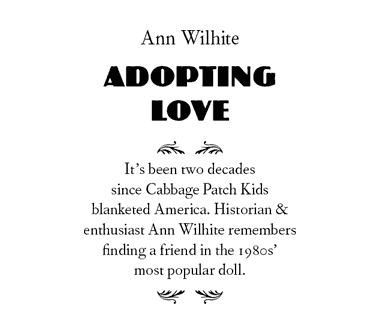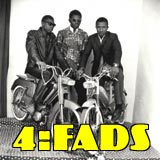
Hula Hoops, the Slinky, and Pet Rocks were distant memories when Cabbage Patch Kids made their mass-market debut in New York City in July, 1983. By fall, consumer demand for the yarn-haired cuddly dolls paralleled those fads of yesteryear. The Shopko chain, like many stores, began to limit numbers:
ONE-OF-A-KIND CABBAGE PATCH KIDS
COMES WITH HIS OR HER OWN NAME,
ADOPTION PAPERS & BIRTH CERTIFICATE.
16" TALL, BABY SOFT BODY, DIMPLES
& BELLY BUTTON! FOR AGES
4 AND UP. LIMIT 1.
MINIMUM 360 PER STORE –
SORRY, NO RAIN CHECKS
The day after Iowa's Sioux City Journal advertised the Kids for $27.99, a huge crowd lined up for Shopko's opening. The Cabbage Patch Kids all sold within thirty minutes.
Media hype and a lemming-like desire to join the in-crowd created an unprecedented demand for Cabbage Patch Kids in 1983 and 1984. To ensure their child would have a Cabbage Patch Kid for Christmas, some parents paid scalper's fees of up to $150. Kansas City postman Edward Pennington flew to London to find a Kid for his eleven-year-old daughter. He succeeded, even though a shipment of one thousand Kids sold out at Harrods within an hour.
Outsiders were baffled by the mad American mobs who were toppling display tables, ripping dolls from the packaging and trampling pregnant women. Witnesses described the scene at a Vermont department store as a "minor earthquake," with plate-glass windows shaking and people screaming at each other. In Tokyo, a shipment of three thousand Kids in February, 1984, "triggered a stampede." Why all this lunacy just to cuddle a Cabbage Patch Kid?
Pundits hastened to explain the frenzy. Dr. Ralph Wittenberg of the Washington Psychiatric Society saw signs of mass hysteria with a destructive power similar to Nazism. Dr. Thomas Plant of the National Institute of Mental Health was intrigued by a product that promised both uniqueness and group identity. Brandeis University psychologist Malcolm Watson concentrated on the baby characteristics of the dolls: big eyes, round cheeks, pudgy arms and legs. Such features, he said, constituted a "releasing mechanism" that triggered a nurturing instinct vital to the preservation of our species.
Cabbage Patch Kids had, as The New York Times reported, "seized the heart of the nation." After years of dolls that cried, talked, walked, dirtied their diapers, and had battery hearts and microchip brains, it was refreshing to find one that did not do anything. All that was needed to bring a Cabbage Patch Kid to life was creativity and imagination. The Kids came sitting in cellophane-windowed boxes, arms outstretched as if asking to be picked up and hugged. A variety of head molds, hair and eye colors, ethnicities and outfits allowed the manufacturer, Coleco Industries, to claim that each Kid was different and special. Birth certificates came with birth dates and double names – such as Disa Flora, Annette Suzie, Nelson Bobby, Giles Hector – and computers reputedly assured that no two names were alike. The paperwork with each Kid also included adoption papers, which the "parent" could register via mail. A year later Coleco sent the doll a birthday card. Consumers were not just buying the Kids to be part of the crowd. They were buying individuality and family. They were buying love.

The idea of "one-of-a-kind" distinctiveness did not originate in a Madison Avenue office, but rather from Xavier Roberts, a poor country boy with a rags-to-riches life story. According to William Hoffman, who interviewed Roberts for his 1984 book Fantasy: The Incredible Cabbage Patch Phenomenon (Taylor Publishing), Roberts grew up in rural Georgia with a widowed mother and five siblings. Surrounded by the folk art of Appalachia, the teenaged Xavier tried his hand at needle sculpting. "I started making soft-sculpture plants and wall hangings, then pigs and clowns, experimenting," he recalls. "I'd had a teddy bear as a little boy. They're cuddly. People like nice soft friendly things to hold." Eventually he tried making children. "My mother showed me how to sew, to mold the fabric. It was like working with clay. I made [the human forms] by hand using a four-way stretch fabric, stuffed them with soft fibers, stitched the mouths, painted the eyes, every one different . . .I couldn't believe the expressions I got with stitching. A tuck here, a pucker there, and the whole face took on life."
Xavier Roberts called his soft sculpture babies "Little People" and said he found them in a cabbage patch. "You know, that's what mothers tell their children when they ask, 'Where did I come from?'" When approached to sell his soft sculpted art, he said, "Well, they're not for sale. But you can adopt them . . . for $30." Xavier's creativity stretched to naming each baby, replete with name tag and birth certificate. People who "adopted" the babies had to swear an oath to love and take care of them.
Adopted through local craft fairs and gift shops, the 22-inch Little People became popular enough that Xavier Roberts decided to widen the market. In July, 1978, he and five friends incorporated Original Appalachian Artworks and purchased an old medical clinic in Cleveland, Georgia, that they renamed BabyLand General Hospital. A miniature wonderland was created to display the Little People in various settings: nursery, school room and playground. Sales staff wore medical uniforms, and a "Mother Cabbage" gave birth on cue. Local seamstresses were recruited to hand stitch the cloth babies, thus freeing Xavier to focus on marketing and sales.
By 1981 the Little People had attracted the attention of ABC's "Real People" program, as well as the Wall Street Journal and Newsweek. Even at prices of $130–150, the Little People sold well. The time seemed ripe to test a mass market. In 1982, Original Appalachian Artworks signed a licensing agreement with Coleco Industries in Connecticut to produce a more affordable version of the soft sculpture babies in their Asian factories. The name "Little People" was changed to "Cabbage Patch Kids," and the vinyl-headed, soft-bodied, 16-inch Kids arrived on toy shelves the following year. Thus began what the Washington Post later called "the greatest doll fad ever to sweep the country."
Three million Coleco Cabbage Patch Kids were sold in 1983 and 20 million more in 1984. Additional toy manufacturers Jesmar in Spain, Tsukuda in Japan, Tri-Ang Pedigree in South Africa, and Lily Ledy in Mexico produced Kids for the international market. But supplies still could not keep up with consumer demand.
Cabbage Patch Kids weren't just children's playthings. Adults were also drawn to the whimsy, fantasy and cuddliness. "I decided a few years ago that I was tired of being grown up," said a mother of four boys who had left the nest. "I decided I liked being eccentric because maybe that made me interesting, at least to myself. So not only is my house full of CPKids, but I carry them around in my purse and my arms, if I feel like it that day. I've given doll gifts to people and they were so touched by having a child's 'toy' to hug. It never fails to bring a smile."
Beginning in 1985, a few enterprising adults even offered camp, prep school and holiday vacation experiences for the Kids. A Kentucky mother, for example, hosted a week-long Summer Adventure camp (including visits to the Kentucky Derby and the Louisville Slugger Museum), and an Ontario woman invited Cabbage Patch Kids to spend Christmas in Canada. After paying a registration fee and packing up suitable clothes and accessories, each Kid traveled by post, sent letters home and returned with photos of the week's activities.
Never just a toy, cuddly Cabbage Patch Kids have offered companionship to the lonely and parenthood for the childless. They were adopted into loving homes and often given all the accoutrements of infancy and childhood: Coleco made pacifiers, disposable diapers, cradles, high chairs, rocking horses, and strollers. Adults have given Kids rooms and even houses of their own, displaying them in scenes with tea sets, school desks, lawn chairs, musical instruments and bunk beds.

Although the craze for the Kids had waned by 1985, the Kids, unlike Pet Rocks, have not disappeared, even since Coleco's bankruptcy in 1988. The mass marketing license passed first to Hasbro, Inc., then to Mattel Toys in 1995. Mattel homogenized the Kids and moved them further away from the original concept of a doll humanized solely by imagination. Mattel Cabbage Patch Kids variously used batteries and microchips to swim and kick, eat snack foods, giggle, sneeze, sing and interact with computers.
Nonetheless, the new millennium brought a U.S. postage stamp depicting a Coleco Cabbage Patch Kid, as well as an exclusive licensing agreement with Toys "R" Us. The U.S. launch of the 21-inch "tru Kids" and 16-inch Babies in 2002 included in-store birthing and adoption events and a "Good Parenting Day." The emphasis has returned to parenting, adoption, imaginative play and one-of-a-kind distinctiveness. Nostalgia also seems to be fueling a new market.
Back in the early 80s, Cabbage Patch Kids were an enthusiastic craze. For a brief time people could buy a sense of community, of oneness with a crowd, and become "somebody." While the phenomenon is no longer a fad, both the mass market Kids and the original soft sculptures are still being made and are still selling steadily to both children and adults. A recent poll by Doll Reader magazine included Cabbage Patch Kids among the "top 30 favorite dolls of all time." The emotions that Cabbage Patch Kids can trigger may be inexplicable to the outsider, but they are very real to those who love them.
Back to Top | Table of Contents | Subscribe to Topic

|

